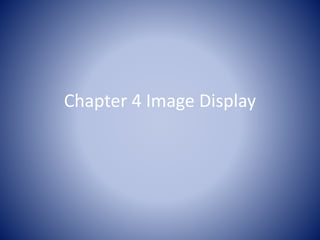
Chapter 4 image display
- 1. Chapter 4 Image Display
- 2. • DISPLAY MONITORS - The display device is usually either a cathode-ray tube (CRT) or some form of flat panel such as a thin- film transistor, liquid crystal display (TFT LCD). - By using DAC change the digital signal from the computer memory back to an analog format so that the image can be displayed on the monitor. - The CRT monitor in many CT systems is basically a standard television set with some modifications that improve image resolution. CRT monitors are heavier, bulkier, hotter, and less durable than the newer LCD monitors. In addition, LCD monitors produce higher luminance and higher spatial resolutions.
- 3. • CAMERAS - The camera is an output device that transfers the image from the monitor to the film. The camera used may be a multiformat camera, although most CT systems today include a laser camera. - WINDOW SETTINGS The way an image is viewed on the computer monitor can be adjusted by changing the window width and window levels. - The gray scale is used to display CT images.
- 4. Display of CT (Window and level) • Gray shade assigned to each pixel value (CT #) • If the image displayed as such: image with very bad contrast (very high latitude) 47 93
- 5. • Windowing: – Assignment of densities to pixel values according to clinical interest – does not disturb original pixel values in memory – Automatically or manually controllable • window • level
- 6. • Window Width - The window width determines the quantity of Hounsfield units represented as shades of gray on a specific image. - The software assigns shades of gray to CT numbers that fall within the range selected. All values higher than the selected range appear white, and any value lower than the range appears black.
- 7. • assume that we have 10 shades of gray available. We have selected 300 as our window width. Therefore, only 300 (of the more than 2,000 possible density values in our scale) will be represented on the image as a shade of gray. All others will be either black or white. In this example, 30 different HU will be grouped together and represented by each shade of gray in the image.
- 8. Window Level - The window level selects which Hounsfield values are displayed as shades of gray. - All values higher than those in the selected range will appear white on the image. All values lower than those in the selected range will appear black on the image.
- 10. IMAGE DISPLAY OPTIONS 1) Region of Interest : Region of interest: an area on the image defined by the operator. Defining a region of interest is the first step in a number of image display and measurement functions. - An ROI is most often circular, but may be elliptic, square, or rectangular, or may be custom drawn by the operator.
- 11. - cursor (+) placed over an area reads out measurement of that area. - If the measurement is 70 HU (indicating unenhanced blood) instead of the expected higher value of contrast-enhanced blood (90–160 HU), then a number of steps could be taken before the examination is continued. 2) Distance Measurements - All CT systems allow distance measurements. This feature is helpful in reporting the size of the abnormality.
- 12. • It is also essential for the placement of a biopsy needle or drainage apparatus. 3) Image Annotation - each image includes facility name, patient name, identification number, date, slice number and thickness, pitch, table location, measurement scale, gray scale, and right and left indicators. - Software allows the operator to annotate specific images with words, phrases, arrows, or other markers
- 13. 4) Reference Image - The reference image function displays the slice lines in corresponding locations on the scout image. This feature aids in localizing slices according to anatomic landmarks.
- 14. 5) Image Magnification - Image magnification is NOT the same as decreasing the display field of view. - image magnification uses only image data and does not improve resolution. 6) Multiple Image Display - four images per frame, six images per frame often varies with the manufacturer.
- 15. 7) Histogram A histogram is a graphical display showing how frequently a range of CT number occurs within an ROI.
- 16. 8) Advanced Display Functions as multiplanar reformatting (MPR). This technique, along with three dimensional reformatting.
- 17. • briefly explain the DAS from beginning until image produced…